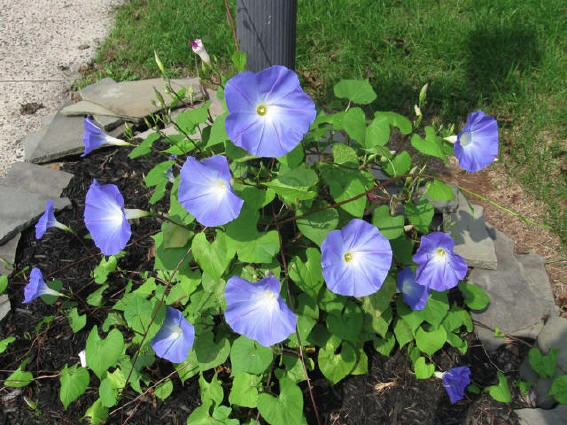 Those stunning velvety "midnight blue" pansies planted in mid-March by the main entrance to Gettysburg
College got me thinking, and thanking, John Beauchamp, Grounds Manager, and the wonderful groundskeepers for the great work they do every day. I wondered if the pansies over-wintered like many of the herbs and flowers this
year. John said they were planted earlier than usual because of soil conditions and spring temperatures. Pansy beds appeared all over campus--thank you!
Those stunning velvety "midnight blue" pansies planted in mid-March by the main entrance to Gettysburg
College got me thinking, and thanking, John Beauchamp, Grounds Manager, and the wonderful groundskeepers for the great work they do every day. I wondered if the pansies over-wintered like many of the herbs and flowers this
year. John said they were planted earlier than usual because of soil conditions and spring temperatures. Pansy beds appeared all over campus--thank you!
That eye-catching blue pansy flowerbed led me to do some research for this article about blue flowers to coincide with the Gettysburg Festival "Blues" theme this year. What a terrific line-up of
musicians, artists, and culinary chefs.
Blue perennials
MG Coordinator Mary Ann Ryan wrote an April newspaper column about Jack Frost: The Perennial of the Year. We learned that this plant has silvery foliage and
grows best in shade but will tolerate some sun in the morning. In the spring, small blue flowers appear resembling forget-me-not flowers. After it finishes blooming, the silver foliage lasts the entire summer and fall. You
shade garden lovers, consider this winner.
Although blue might be the least common color in the garden, there are actually 44 main families of plants containing blue flowers. (A Book of Blue Flowers by Robert Geneve.) Families such as the
Astor, Borage (Kathy Glahn told me it’s her favorite blue flower because it re-seeds, tolerates heat, and is easy to grow), Snapdragon and Bellflower are true blue. Color experts say blue is a cooling color and provides calm
and comfort. I must confess that I admire friends with beautifully landscaped shade gardens.
A true-blue perennial garden that matches the color of the sky (what my family calls a "Denver Day") might include the Pulmonaria, or Bethlehem Sage. The flowers resemble miniature morning glories,
like moist soil and are partial to full shade. They are low growing and easy to divide in the spring. Another blue perennial that is very showy in the garden is Brunnera or Siberian Bugloss. Again, the growing conditions
require moist soil and partial shade. It grows 12-18 inches and the clusters of small flowers look like blue stars floating above the leaves.
Ask gardeners about their favorite blue flower and often they say Hydrangea. The large clusters of long lasting flowers bloom from spring to late summer. Most species are deciduous shrubs planted
where they enjoy morning sun and afternoon shade. To encourage blue flowers, grow this plant in soil that has a soil pH of 5.2 to 5.5.
Blue flowering annuals
We all have our favorites. Each year I am drawn to the Ageratum because it was a favorite for our young children to plant in our rock garden. The fluffy blue flowers thrive in containers and in a
window box with red geraniums and white petunias for Memorial Day and the Fourth of July.
Don’t you just love Morning Glories? I bought a small seedling last year at the Farmer’s Market and it bloomed around my lamppost in full sun all summer.

Bulbs that add blue to your garden include alliums, hyacinths, grape hyacinths, and iris. That is another article to come.
Amazed by the number of blue flowers? The list continues with summer perennials such as Delphiniums, Echinops, Phlox, Salvias, and Veronica. This growing season start singing the blues in your garden
or design a blue bed for the fall. And be sure to visit the Adams County Master Gardener Trial Garden for more great gardening ideas.
Read other articles on plants and gardens